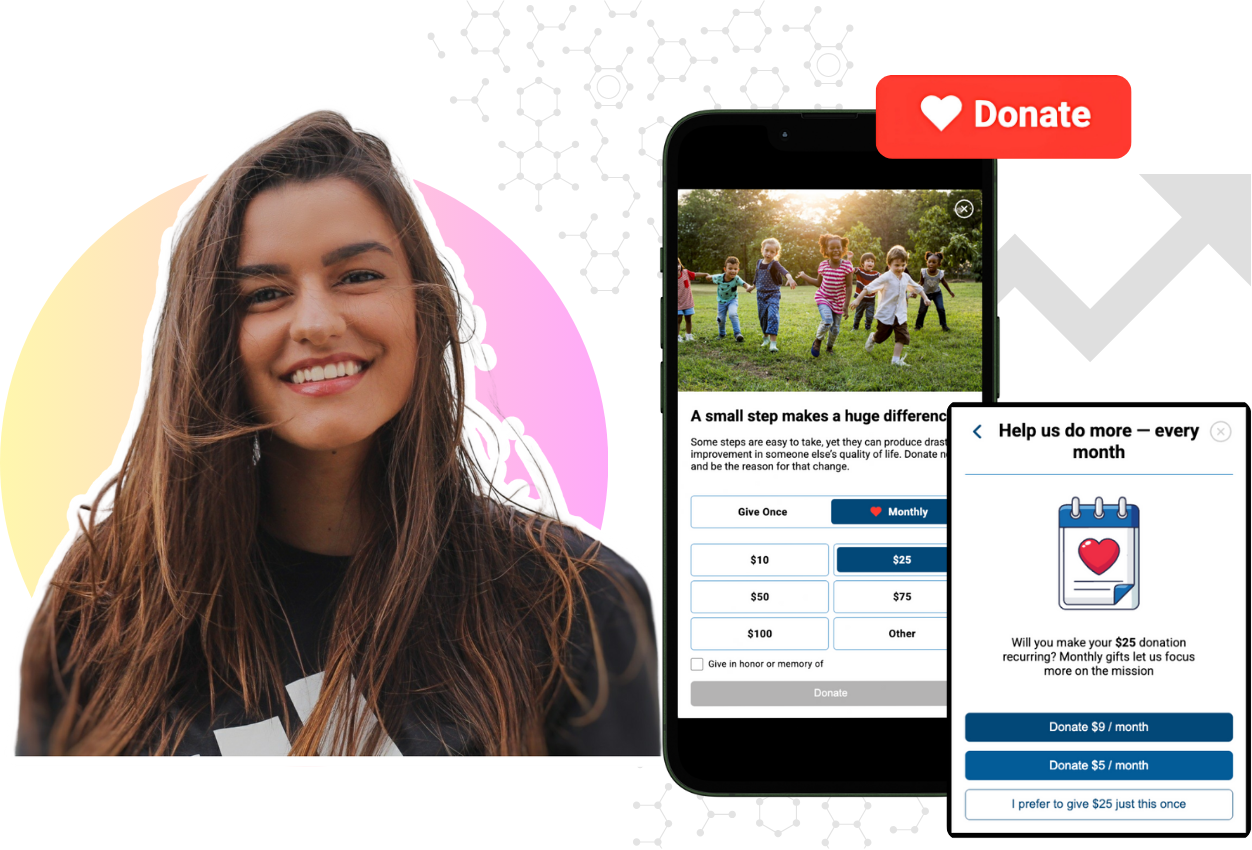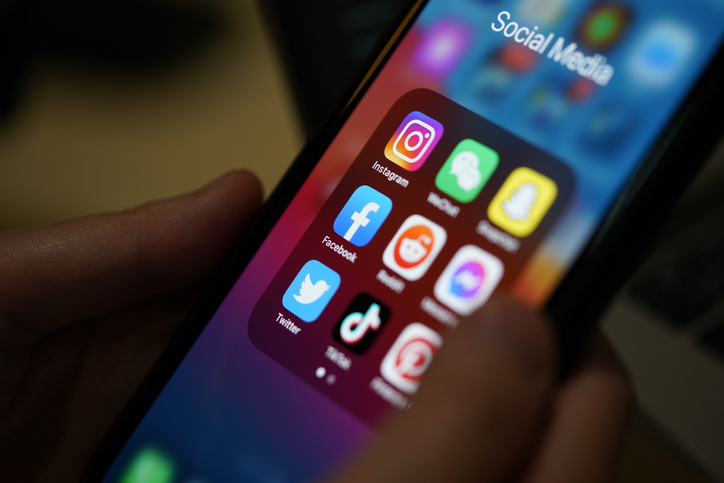Your Guide to Text-to-Give Fundraising Success
These days, smartphones have the power to do almost anything. From little things like checking your email or watching live TV, to controlling your...

Mobile-First Pop-Up Donation Form
Launch mobile-first pop-up forms in minutes, use built-in tools to capture more donations, and optimize the giving experience—no dev team required.
New to online donation pages for your nonprofit? Start here.
Donation page A/B testing - no science degree needed.
Keep your donation page loading fast - and drive higher conversions.

The 4 Types of Online Donation Experiences
89% of donors leave without giving. Learn how to use the right donation form to close the gap and boost conversions.

Social media for nonprofits is a vital part of any fundraising strategy. It’s not only a great way to spread awareness about your cause, but also allows others to fundraise on your behalf. We know that people choose to donate for a multitude of reasons. One major reason people may donate is because they saw a compelling story told through social media.
According to NPSource, 55% of people who engage with nonprofits on social media end up taking some sort of action. Of those, 59% follow through with a donation.1 It’s important to incorporate the use of social media into your fundraising strategy so you can utilize this highly valuable avenue for donations. For a nonprofit, building a strong supporter base, engaging with your donors, and telling your story are essential to your cause’s success and should be among your org's digital fundraising best practices. With social media, you can do all three.
This now raises the questions of what are the best fundraising apps for nonprofits and what features does each platform have for nonprofits? Keep reading below for a guide to the perfect fundraiser through a successful social media fundraising campaign.
With the usage of social media platforms growing by the day, it’s become increasingly difficult to know where to be online. It’s no secret that nonprofit fundraisers are almost always strapped for time, resources, and people, so adding the responsibility of running a social media account can seem like one more daunting task. This is where knowing your audience comes into play. You want to be on the platform(s) where you know your supporters are already. One way to find out is to simply ask them! With iDonate’s Text-to-Give feature, you can quickly poll your donors and find the answers you’re looking for.
Let’s look at the top social media platforms today and dive into their differences to help pinpoint which one will work for your organization:
No matter which platform you go with, social media is a great tool for any event, especially one like Giving Tuesday. The more you utilize these platforms to share your message, the greater chance of success you'll have.
Defiance College used social media alongside iDonate's Text-to-Give feature to reach a wider audience than they ever have before. →
Hopefully now it's a little clearer on the differences between these social media platforms. But now, let's dive deeper into what makes these platforms so unique for nonprofits, which ones might be the best fundraising apps for nonprofits, and how you can use these features for your digital fundraising best practices and social media fundraising success.
What are some Facebook tools for nonprofits? There are two avenues in which your nonprofit can collect donations on Facebook:
“Facebook fundraising” is the term that encompasses all the Charitable Giving Tools your NPO can utilize through this platform. These tools include:
As part of their increased awareness efforts, ZOE International has found that social media is a central part of their online engagement. →
Facebook and Instagram have a lot of overlap, as the two are owned by their parent company, Meta. To fundraise on Instagram, you’re able to not only post compelling content, but also add a donation button to your profile. Requirements for your nonprofit to fundraise on Instagram include:
Twitter is all about engaging with your community and reaching potential supporters. A great way to broaden your reach is to develop a hashtag strategy that will help create buzz around your fundraiser and allow others to post with the tag as well. An easy way to do so is to simply look up what is trending. In the app, Twitter shows all users the top hashtags and topics that people are talking about, so use these as a starting point to work your campaign around.
Twitter is a great way to listen to what others are saying about issues that affect your mission. This will help when you’re writing content and help you tell your story better. With a 280-character limit, you’ll learn to keep your message simple and engaging at the same time. Just remember, spaces, numbers, hashtags, and even emojis count as a character, so be sure to use the space wisely. Use your message to share your story and link out to your organization's fundraising page.
There are a variety of fundraising solutions that LinkedIn has to offer. LinkedIn’s Sales Navigator tool helps nonprofit organizations to map their network, identify strategic prospects, and provide real-time updates on key prospects and donors. With this tool you can find the right audience, get the right information, and send the right message. This helps you get your message to key decision makers that can make a big difference for your cause.
Telling stories is key to Alabama Baptist Children's Homes' strategy, and they use social media as an important tool to carry them out. →
There are multiple tools that partnering with TikTok can provide your nonprofit in your social media fundraising efforts:
TikTok has “Donation Stickers” that creators can add to their videos and live streams, like what we’ve seen with other platforms. However, TikTok is selective of which organizations can be recipients of donations. To apply for this, you must:
There are other ways you can fundraise on TikTok without being a designated nonprofit for Donation Stickers. Two key ways are to post engaging content that appeal to people’s emotions regularly, and use relevant hashtags. You can also display your fundraiser on your profile with a link – this is available to every user on TikTok.
With the right strategy and engagement on the right platform, social media for nonprofits not only help strengthen the relationships you have with your donors, but also raise more awareness and funds so that your organization can better carry out its mission.
When you add social media fundraising to iDonate's Digital Fundraising Platform, your nonprofit's potential grows even more. Contact us today to see how we can get you started.
1 NPSource: Social Media Giving Statistics For Nonprofits
2 Omnicore Agency: 63 Facebook Statistics You Need to Know in 2022
3 Hootsuite: 150+ Social Media Statistics that Matter to Marketers in 2022
4 Hootsuite: 23 Important TikTok Stats Marketers Need to Know in 2022

These days, smartphones have the power to do almost anything. From little things like checking your email or watching live TV, to controlling your...

Today’s donors expect more. When they choose to give online, they expect simplicity, transparency, and security. When your giving platform checks...

Technology and people are inseparable today. That seems obvious, of course. We’re all so accustomed to the myriad of ways technology influences our...